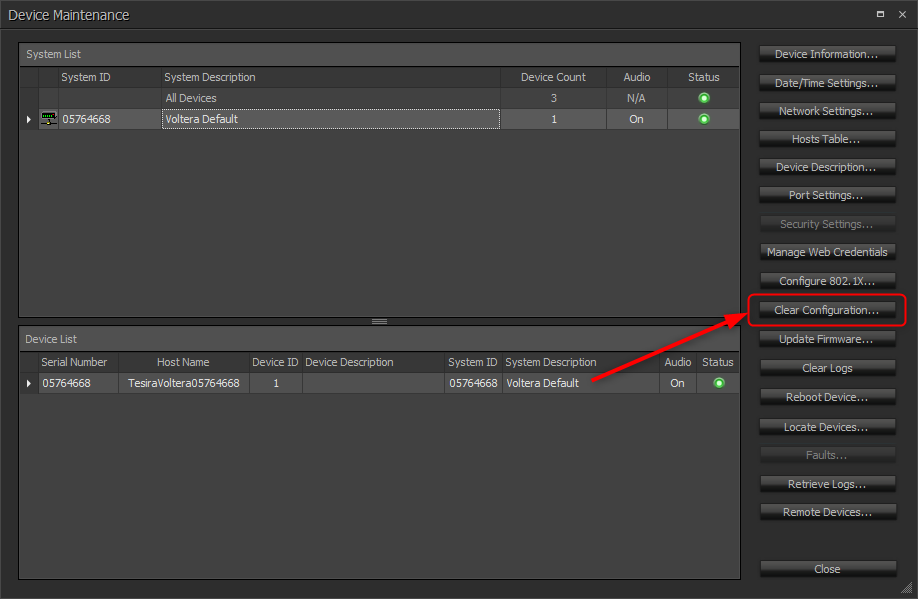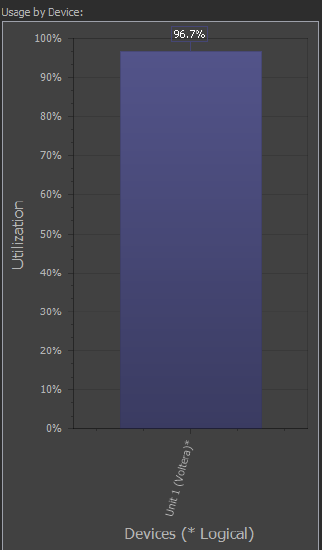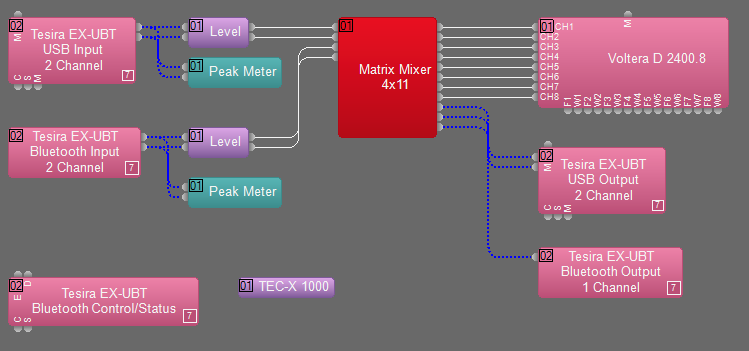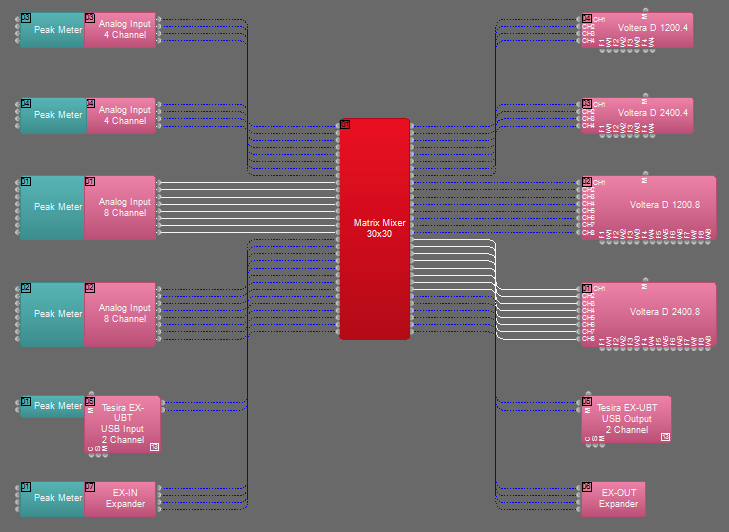Voltera D and D M - Tesira Configuration
Voltera D and D M amplified loudspeaker controllers provide two options for configuration, management, and deployment.
- A Voltera D can be programmed using Tesira software, either as a standalone solution or as part of a larger Tesira system.
- Alternately, if the site consists of just Voltera D devices, Biamp's VenueTune software may be used for a streamlined, loudspeaker-centric approach built around Phases and Actions.
This article provides additional information for configuring a Voltera D using theTesira software. If any of the following conditions apply, then Tesira software would be the appropriate choice.
- There is a desire to create a custom-built system where the Voltera D hosts:
- Expanders, and/or
- TEC-X control panels, and/or
- Custom-designed basic input processing (source selectors etc)
- There are other Tesira devices included in the same system design as Voltera D and the desire is to have a single project file for it or to route AVB audio between the devices
- Sources connected to Voltera D analog inputs need to be available to other devices that share the same media network.
- The added power of a full featured Tesira DSP is required (Voltera D M)
Tesira software
Tesira programmers will find a familiar path to integrate Voltera D into their designs. Tesira software may be used to configure a stand-alone Voltera D, a system that consists of multiple Voltera D, or a mix of Voltera D and other Tesira devices, such as server class and expander class endpoints.
Please see the Voltera D section of the Tesira Help File for more information on block dialogs and related programming options.
Clear Configuration
Votera D ships ready for configuration with Biamp's VenueTune software. It is running a default layout file to support this. This file cannot be retrieved using Tesira software and must first be cleared from the device before equipment table assignment and configuration from Tesira can be done.

Proxy behavior and DSP overhead
Voltera D can act as a proxy for Tesira expanders. Up to 5 expanders may be proxied from the 4-channel models and up to 9 on the 8-channel versions. A small amount of available DSP overhead in Voltera D allows for input/output expansion and routing even in systems where Voltera D is the only Tesira server class device.



The below table provides an approximation of the default DSP usage and overhead. It is recommended to create the Tesira layout file ahead of time to determine the needed DSP usage for a project. If the DSP requirements exceed the available overhead in Voltera D, another Tesira server class device, such as a TesiraFORTE or Server IO may be added to the system design.
| Voltera Channel Count | DSP in use (failover / analog input mode) | Available DSP (failover / analog input mode) |
| 4 channel | 96.4% / 93.9% | 3.6% / 6.1% |
| 8 channel | 95.2% / 92.6% | 4.8% / 7.4% |
Votlera D M includes DSP overhead beyond what is found in the Voltera D models. This provides DSP capabilities similar to having a TesiraFORTÉ in addition to the loudspeaker processing signal flow.
| Voltera D M Channel Count | DSP in use (failover / analog input mode) | Available DSP (failover / analog input mode) |
| 2 channel | 48.7% / 47.6% | 51.3% / 52.4% |
| 4 channel | 47.5% / 46.3% | 52.5% / 53.7% |
Input expansion vs failover
Voltera D analog inputs can be configured as failover to network media, or as analog input expansion for distributed sources. Input expansion allows for analog sources connected directly to one Voltera D to be routable within Tesira to other outputs in the system. This may be other Voltera Ds, or other Tesira devices capable of receiving audio over the appropriate media network
Input Expansion example


Failover example
The Input Priority Routing section includes options to configure failover. From the Tesira help file:
Input priority routing allows the user to select the priority routing of physical input in a failover scenario. By default, each channel will be set as 1:1 priority routing. Digital is routed from the port on the software block, Analog is routed from the back panel of the device (analog inputs). Configure the routing as desired for each channel using the Digital / Analog toggle and analog routing drop down. Choosing an Analog Input option from the drop-down on a channel will select that input as the failover for the input on the current channel. In scenarios where failover is not desired, choose the analog toggle option and select the "none" option from the drop-down menu.

Loss of digital media on any channel will trigger failover for all channels configured with an analog failover channel.
Dante failover can be detected when a loss of a link to the media network is detected, or loss of the Dante subscription.
Pre Dante failover
Channels 1-4 are receiving audio over Dante, with a backup analog source connected to input 1 of the Voltera D.

Post Dante failover
Voltera D detects a loss of Dante flow and fails over to the defined analog input.

AVB failover will occur when loss of AVB stream is detected.
Pre AVB failover
Voltera D is receiving AVB streams from an EX-UBT and EX-IO.

Post AVB failover
Voltera D detects an inactive AVB stream and fails over to the defined analog input.

Sleep vs Standby
Voltera D supports two low power modes - Sleep and Standby. This is set in Tesira software, from the Advanced Configuration page in the Control Dialog. This setting can be changed offline and then loaded to a system, or while connected live with software.
Sleep/Standby can be triggered by a GPIO connection on the rear of the unit, or using the Tesira Text Protocol (TTP).
Standby
Standby is the only option when the device is unconfigured. A device in Standby is indicated by a system warning in System Status. Recovery from Standby is about 3 seconds until audio is restored.

Sleep
Sleep puts the device in an extremely low power mode, where the total power consumed is constrained to less that 5W. In this mode, the primary processor, DSP, and amplifiers are shutdown.
A sleeping device can still be discovered in Tesira Device Maintenance, with the status indicator turned off.

Furthermore, a device configured for Sleep will show controls for Sleep and Wake under the Device Information option.


When connecting to a system with sleeping devices, Tesira software will provide a status alert. Software will not be able to access the Voltera D control dialog or any other blocks hosted on the sleeping device until it is fully awake.


Once Waking a device, it will take about 90 seconds until audio is restored and about 3 minutes until software communication to the Control Dialog is functional.
Tesira Presets
Tesira systems consisting of just Voltera D devices are capable of supporting Tesira configurations with presets. Presets can be used to change routes from inputs to outputs, adjust levels and muting, as well as aid in managing logic.
It should be noted that the Votlera D block itself cannot be added to a preset. There is a DSP signal chain inside the block that is managed from the block's control dialog. Any changes to routes or levels can be done in mixers, routers, level controls etc... that are ahead of the Voltera D output block in the signal chain.

